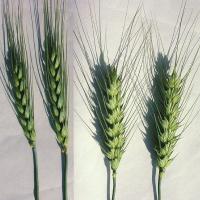Diagnosing boron deficiency in wheat
Boron deficiency is rare in cereals in Western Australia (WA) and will impact broadleaf crops such as lupin and canola before affecting cereals like wheat and barley. Boron does not easily move around the plant therefore a deficiency is most likely to be seen in the younger tissues first.
What to look for
- Sandier more acidic parts of the paddock will be most affected.
Paddock
- In wheat symptoms appear first on the youngest leaf and gradually spread to older growth.
- First sign of boron deficiency is leaf splitting close to the mid rib accompanied by.
- saw tooth notches along the leaf edge.
- In severe cases tillering increases, shoots wither and new leaves die back from tip.
Plant
What else could it be
| Condition | Similarities | Differences |
|---|---|---|
| Diagnosing copper deficiency in wheat | Youngest leaf dies | Copper deficiency is characterised by pale plants, head death and leaf tip death. |
| Diagnosing calcium deficiency in wheat | Youngest leaf dies | With calcium deficiency the leaf tip dies, twists and tears. |
Where does it occur?
- Areas most at risk are those receiving more than 600 millimetres annual rainfall and have sandy, acid soils - such as the sand plains of the Dandaragan plateau stretching from the West Midlands to the Eradu sandplain.
Management strategies

Soil application

Spraying foliar

- Soil or foliar applications of boron.
- Soil applications generally last longer but can be leached from acidic, sandy soils. Avoid using higher rates than necessary as these can cause boron toxicity in plants.
- Foliar applications act rapidly but timing of application is important to avoid irreversible damage.
How can it be monitored?

Tissue test

Soil test
- Use the youngest emerged blade (YEB) for plant testing.
- There is no plant calibration for WA, as field responses to boron fertiliser have not been measured. However at mid-tillering,YEB values below 2-4 milligrams per kilogram (mg/kg) are marginal, and values greater than 5-10 mg/kg indicate boron adequacy.
- There is no calibrated soil test for boron deficiency in wheat. Soil testing may be useful on deep sands but on duplex soils subsoil boron levels should also be determined.
See also
Further information
Where to go for expert help
Page last updated: Monday, 20 April 2015 - 8:47am




